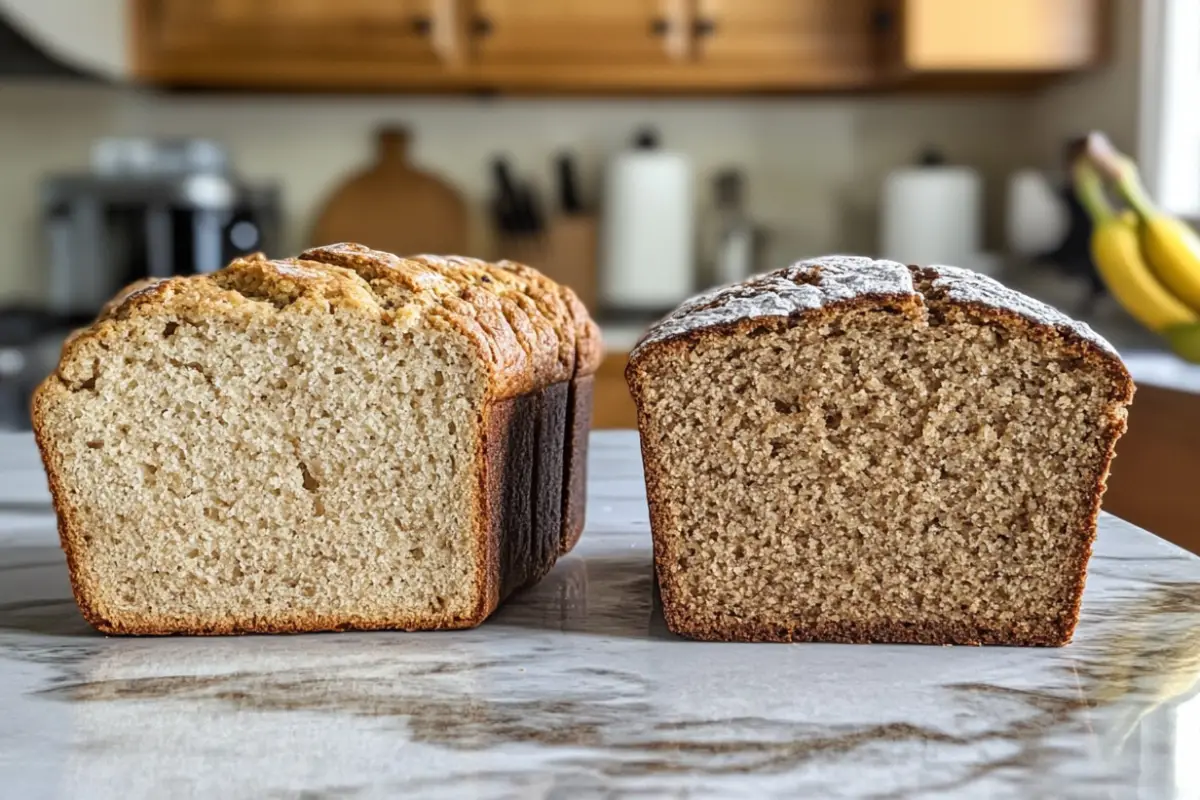Last Updated on February 12, 2025 by Souhail
When it comes to choosing between banana bread and traditional bread, the debate often sparks interest. Is banana bread healthier than bread? On the surface, banana bread may seem like the healthier choice, thanks to its association with bananas—a fruit synonymous with vitamins and fiber. However, the truth isn’t so straightforward. In this article, we’ll break down the nutritional profiles, explore health benefits and drawbacks, and discuss how different recipes and preparations can significantly impact the answer to this question.
Whether you’re curious about its sugar content, nutrient density, or role in a balanced diet, this guide will help you understand the factors that make banana bread either a healthful option or a sneaky indulgence.
Table of contents
- Nutritional Showdown: Banana Bread vs. Regular Bread
- The Health Benefits of Banana Bread
- When Regular Bread Takes the Lead
- Is Banana Bread Healthier Than Bread? It Depends!
- Tips for Making Banana Bread Healthier
- Glycemic Index Comparison: How Banana Bread and Regular Bread Affect Blood Sugar
- When to Choose Bread Over Banana Bread (and Vice Versa)
- Homemade vs. Store-Bought: What’s Healthier?
- FAQs About Banana Bread vs. Regular Bread
- Final Thoughts
Nutritional Showdown: Banana Bread vs. Regular Bread
To determine whether banana bread is truly healthier than regular bread, let’s first look at their basic compositions.
Calories and Macronutrients
- Banana Bread: A standard slice of banana bread (depending on the recipe) contains between 150 and 250 calories. It’s often rich in carbohydrates and fats, thanks to added sugar, butter, or oil, and can contain about 10-15 grams of sugar per slice.
- Regular Bread: A slice of plain white bread or whole wheat bread typically has 70-120 calories. Regular bread is lower in sugar and fat but still provides carbohydrates for energy. Whole wheat varieties also offer more fiber and nutrients than their white counterparts.
Key Nutritional Factors
- Sugar Content
Banana bread tends to contain significantly more sugar than regular bread, especially if made with sweeteners or chocolate chips. Sugar adds flavor but can spike blood sugar levels and contribute to weight gain if consumed excessively. - Fiber
Thanks to bananas, banana bread often has a bit more fiber than white bread, especially if whole wheat flour is used. However, it may still fall short of the fiber content in whole grain bread. - Added Ingredients
Regular bread generally contains fewer ingredients, while banana bread often includes extras like nuts, chocolate, or spices. These can add nutrients like healthy fats and antioxidants but also increase calorie count. - Protein
Both banana bread and regular bread are not particularly high in protein. However, recipes for banana bread can be tweaked to include ingredients like Greek yogurt or protein powder for a protein boost.
The Health Benefits of Banana Bread
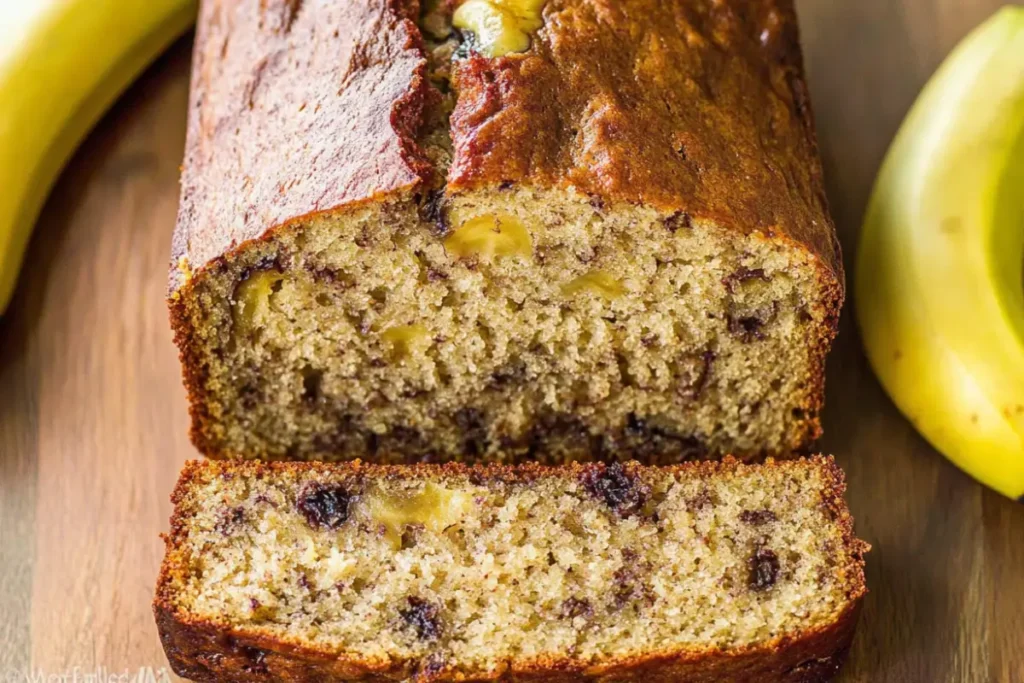
While banana bread is not inherently “healthier” than bread, it does come with some potential perks when prepared thoughtfully:
1. Natural Sweetness from Bananas
Bananas are rich in potassium, vitamin C, and vitamin B6. Using overripe bananas as a sweetener can reduce the need for refined sugar in recipes.
2. Potential for Customization
Banana bread is highly adaptable. Swapping out white flour for whole wheat flour or almond flour can enhance fiber and nutrient content. Using healthier fats, like coconut oil, or replacing sugar with honey or maple syrup can also make a big difference.
3. Energy-Dense Snack
For those needing a quick source of energy—like athletes or busy individuals—banana bread offers a mix of carbohydrates and fats that can provide a boost.
When Regular Bread Takes the Lead
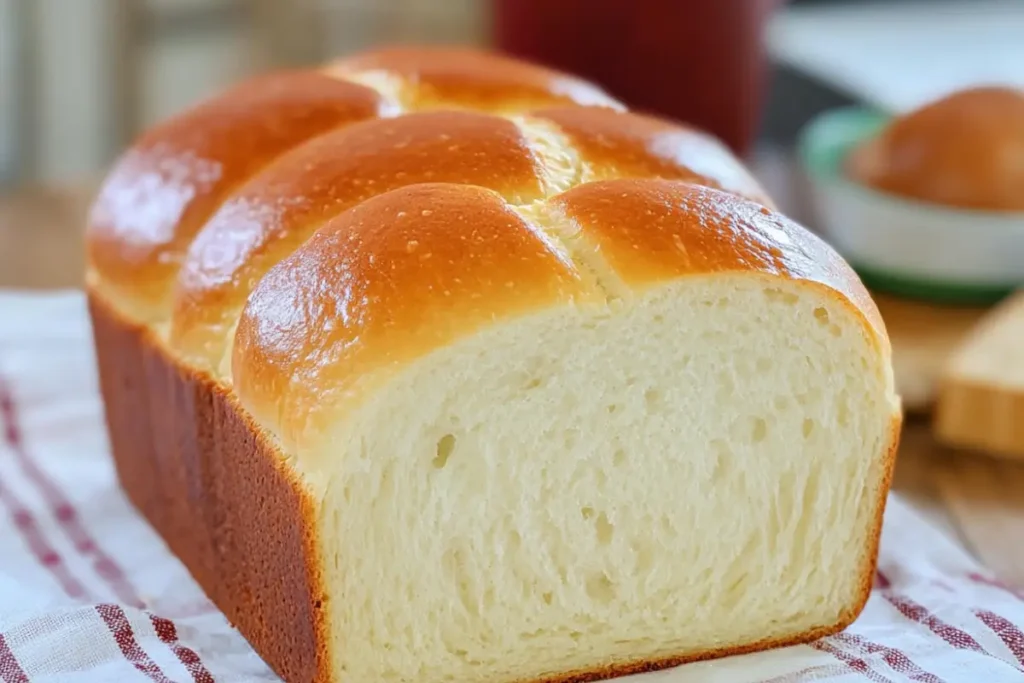
Regular bread has its own health advantages, particularly when you choose whole grain or sprouted varieties:
1. Lower Caloric Density
A slice of whole grain bread is typically less calorie-dense than banana bread, making it a better option for those monitoring their calorie intake.
2. Simpler Ingredients
With fewer added sugars and fats, regular bread—especially homemade or whole wheat—often aligns better with a clean eating approach.
3. Supports Balanced Diets
Whole grain bread is a good source of complex carbohydrates, offering sustained energy and supporting gut health through its higher fiber content.
Is Banana Bread Healthier Than Bread? It Depends!
The answer to this question largely depends on how each is made and consumed:
- Homemade Banana Bread: Using wholesome ingredients like whole wheat flour, natural sweeteners, and healthy fats can make banana bread a nutritious choice.
- Store-Bought Banana Bread: Often loaded with refined sugar, preservatives, and unhealthy fats, store-bought options are more like dessert than bread.
- White vs. Whole Grain Bread: Regular bread can range from nutrient-poor white bread to nutrient-dense whole grain bread, which offers significant health benefits.
Tips for Making Banana Bread Healthier
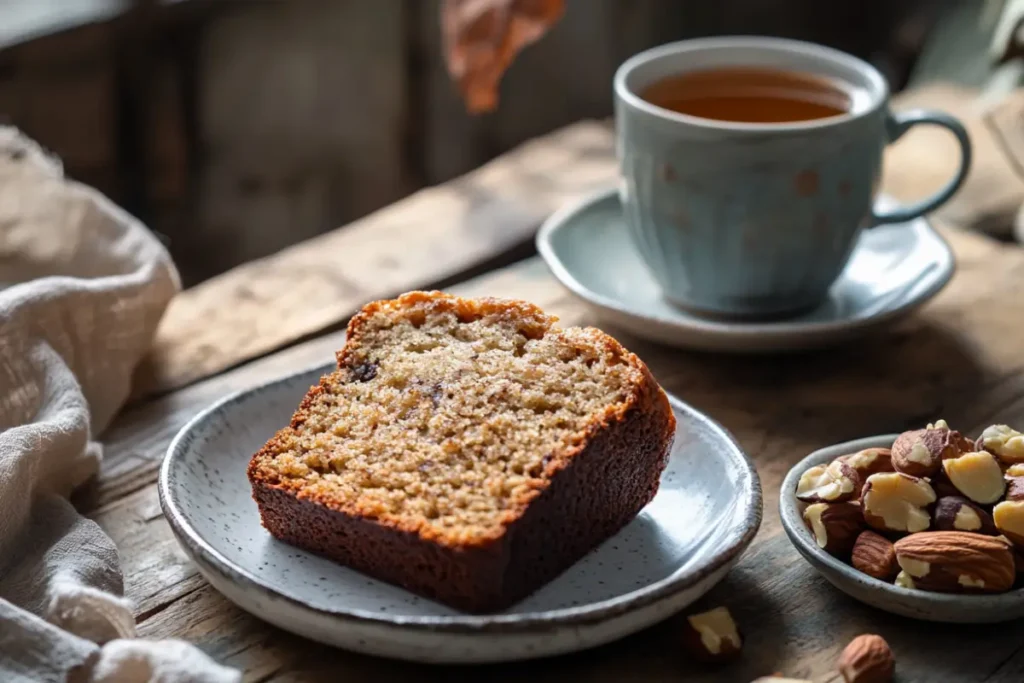
If you love banana bread but want to make it a healthier choice, here are some tips:
- Opt for Whole Grain or Almond Flour
These flours add fiber and nutrients while reducing refined carbohydrates. - Use Less Sugar
Overripe bananas add natural sweetness. Try reducing added sugar by 50% or replacing it with honey or stevia. - Incorporate Nuts or Seeds
Add walnuts, chia seeds, or flaxseeds for extra fiber, protein, and omega-3s. - Swap Butter for Healthier Fats
Coconut oil or applesauce can replace butter to lower saturated fat content. - Add Protein
Mix in Greek yogurt, cottage cheese, or a scoop of protein powder to boost protein levels.
Glycemic Index Comparison: How Banana Bread and Regular Bread Affect Blood Sugar
One of the critical factors in determining whether banana bread is healthier than bread is how each impacts blood sugar levels. This is especially important for individuals managing diabetes or seeking to maintain steady energy levels throughout the day.
What Is the Glycemic Index?
The glycemic index (GI) is a measure of how quickly a food raises blood sugar levels. Foods with a lower GI release glucose into the bloodstream more slowly, providing sustained energy. Foods with a higher GI cause a rapid spike in blood sugar, followed by a crash, which can lead to hunger and fatigue.
Banana Bread: Higher on the GI Scale
Most traditional banana bread recipes have a relatively high glycemic index. This is because of the combination of ripe bananas (which are naturally sweet and higher in sugar when overripe), refined flour, and added sugars. These ingredients can cause a rapid increase in blood sugar levels.
- A typical slice of banana bread has a GI of 55–70, depending on the recipe.
- This GI level categorizes banana bread as moderate to high, meaning it may not be the best choice for those needing stable energy or managing blood sugar issues.
Regular Bread: The GI Varies
The glycemic index of regular bread varies widely depending on the type:
- White Bread: Has a high GI, often around 70–80, making it less ideal for blood sugar control.
- Whole Grain Bread: Offers a lower GI, typically around 50–60, as the fiber content slows down digestion and glucose absorption.
- Sprouted Grain Bread: One of the best options for a lower GI, sprouted bread falls in the 40–50 range, making it excellent for long-lasting energy.
The Verdict
While both banana bread and white bread can cause blood sugar spikes, whole grain or sprouted bread provides a healthier alternative with a lower glycemic index. If you love banana bread but are mindful of your GI, consider recipes with whole grain flour and natural sweeteners to reduce its impact on blood sugar.
When to Choose Bread Over Banana Bread (and Vice Versa)
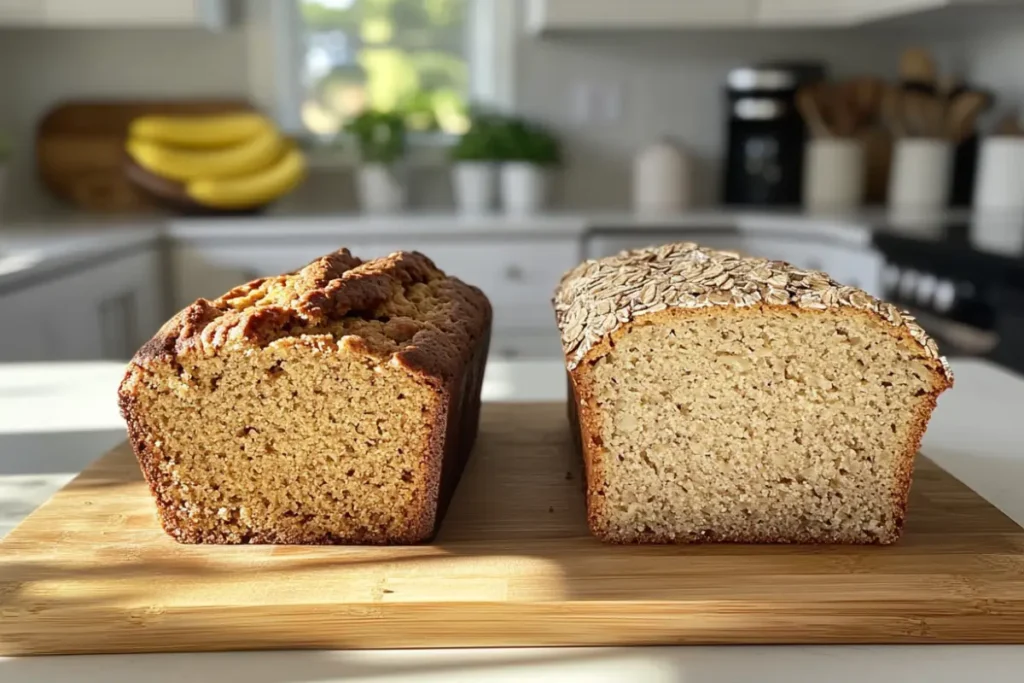
Banana bread and regular bread serve different purposes, and each has its ideal use case. Deciding which is better depends on your nutritional needs, lifestyle, and preferences.
Choose Banana Bread When:
- You Need an Energy Boost
Thanks to its mix of carbohydrates and fats, banana bread can serve as a great pre-workout snack or a pick-me-up during a busy day. - You Crave a Sweet Treat
Banana bread offers a sweet and satisfying alternative to pastries, donuts, or cakes. Opt for a healthier recipe to keep indulgence guilt-free. - You Want Nutrient Variety
Banana bread recipes can incorporate nutrient-rich ingredients like nuts, seeds, and whole grains, offering more than just a simple slice of bread.
Choose Regular Bread When:
- You’re Looking for a Low-Calorie Option
Whole grain bread is lower in calories and sugar compared to most banana bread recipes, making it ideal for weight management. - You Want a Versatile Base
Bread is far more versatile for savory dishes like sandwiches, toast, or pairing with soups and salads. - You Need Fiber for Gut Health
Whole grain bread can provide more dietary fiber, supporting better digestion and long-lasting fullness. - You’re Watching Your Sugar Intake
With little to no added sugar, regular bread—particularly whole grain varieties—is a better choice for those monitoring blood sugar levels.
The Key Takeaway
Banana bread shines as a flavorful treat or energy-dense snack, while regular bread is better suited for daily consumption, especially when you need a low-calorie, high-fiber option. Both can have a place in a balanced diet when consumed thoughtfully.
Homemade vs. Store-Bought: What’s Healthier?
When debating between banana bread and regular bread, another factor to consider is whether you’re buying pre-packaged versions or making them at home. The source of your bread can significantly affect its nutritional value.
Store-Bought Banana Bread
- High in Sugar and Preservatives
Most store-bought banana bread is loaded with sugar, unhealthy fats, and artificial preservatives to extend shelf life. A single slice can pack up to 20 grams of sugar—nearly your entire daily limit! - Low in Nutrients
Pre-packaged banana bread often uses refined flour and lacks the nutrient density of homemade versions with whole grains, nuts, or seeds. - Convenient but Less Customizable
While store-bought options save time, they lack the flexibility to adapt ingredients to your dietary needs, such as reducing sugar or using gluten-free flour.
Store-Bought Regular Bread
- Wide Range of Options
From white bread to whole grain and sprouted varieties, store-bought bread offers a range of choices. Look for options labeled “100% whole grain” or “sprouted” for maximum health benefits. - Hidden Additives
Many brands add emulsifiers, sweeteners, and preservatives to maintain texture and extend shelf life. Always check the ingredient list for additives you want to avoid. - Affordable and Widely Available
Bread is an economical staple and often easier to source than high-quality banana bread.
Homemade Banana Bread
- Complete Ingredient Control
Making banana bread at home lets you customize ingredients, swapping refined sugar for natural sweeteners, or using whole grain flours for added fiber. - Added Nutritional Value
Homemade recipes can include nutrient-packed extras like chia seeds, walnuts, or even shredded zucchini for moisture and vitamins. - Freshness Without Preservatives
By baking at home, you avoid the artificial preservatives found in store-bought options.
Homemade Regular Bread
- Cleaner Ingredients
Baking bread at home ensures you can skip unnecessary additives and use high-quality ingredients like whole grain flours. - Time-Intensive
Bread-making, especially with yeast, can be time-consuming and requires some skill to perfect.
Which Is Healthier?
In general, homemade versions of both banana bread and regular bread are healthier than store-bought options. Homemade banana bread, made with nutrient-dense ingredients, can compete with whole grain bread for healthfulness. Store-bought options, however, often tip the scales toward less healthy, processed foods.
FAQs About Banana Bread vs. Regular Bread
Banana bread can be part of a weight-loss plan if made with healthier ingredients and consumed in moderation. Opt for recipes using whole grain flour, minimal sugar, and healthy fats like coconut oil. Be mindful of portion sizes, as banana bread is calorie-dense compared to regular bread.
Banana bread is more of a treat or snack than a daily staple like regular bread. While it contains some beneficial nutrients from bananas and other add-ins, it typically has higher sugar and fat content. Regular whole grain bread is better for daily meals like sandwiches or as a source of sustained energy.
To make banana bread healthier, use whole grain or almond flour instead of white flour, natural sweeteners like mashed bananas or honey, and add nutrient-dense extras like walnuts, chia seeds, or flaxseeds. Replacing butter with applesauce or Greek yogurt can also reduce saturated fat content.
Whole grain bread is generally healthier due to its lower calorie count, higher fiber content, and lack of added sugars. However, homemade banana bread with wholesome ingredients can offer comparable nutritional benefits, particularly when enriched with healthy add-ins like nuts and seeds.
You can replace sugar in banana bread with natural sweeteners like ripe mashed bananas, honey, maple syrup, or coconut sugar. These alternatives not only reduce refined sugar but also add subtle flavors and nutrients to your banana bread.
Final Thoughts
So, is banana bread healthier than bread? The answer depends on how each is prepared and consumed. While banana bread can be nutrient-rich and satisfying when made with wholesome ingredients, traditional whole grain bread often wins in terms of simplicity, lower calories, and higher fiber content. Both can have a place in a balanced diet—banana bread as an occasional treat or energy-dense snack, and regular bread as a versatile daily staple.
If you’re a fan of banana bread and want to enjoy it more healthfully, why not try making it at home? Customizing recipes with natural sweeteners, whole grains, or healthy fats can transform banana bread into a delicious, guilt-free option. And for those looking to explore unique variations, check out our article on How to Quickly Make Banana Bread Without Butter for a lighter, dairy-free version that’s sure to delight.
By carefully choosing recipes and being mindful of portion sizes, you can enjoy the best of both worlds—whether you’re craving the sweet comfort of banana bread or the hearty simplicity of a slice of whole grain bread. Let us know your thoughts in the comments, and feel free to share your own tips for making banana bread healthier!

